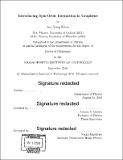Introducing spin-orbit interaction in graphene
Author(s)
Khoo, Jun Yong
DownloadFull printable version (16.34Mb)
Alternative title
Introducing SOI in graphene
Other Contributors
Massachusetts Institute of Technology. Department of Physics.
Advisor
Leonid S. Levitov.
Terms of use
Metadata
Show full item recordAbstract
The excellent electron properties of graphene, an atomically-thin material with record-high carrier mobility and gate tunability, make it central to modern nanoscience. However, the spin-orbit interaction (SOI) naturally present in graphene is extremely weak and has yet to be observed experimentally. This presents an obstacle for accessing novel phenomena in transport and optics, in particular those related to topological properties. This thesis seeks to address this limitation by artificially introducing SOI in graphene sandwiched between other atomically-thin materials that can produce an interfacial SOI in graphene. In particular, it is demonstrated that a strong SOI, naturally present in the two-dimensional materials such as transition metal dichalcogenides (TMD), can be partially transferred to graphene via the proximity effect. We predict a range of novel phenomena arising in graphene bilayers with layer-asymmetric SOI induced by a proximal TMD layer. These include a gate-tunable SOI, a gate-tunable intrinsic valley-Hall conductivity, as well as a gate-tunable edge conductivity, to name just a few. These findings will facilitate exploring previously inaccessible spin-related phenomena in graphene and other van der Waals heterostructures.
Description
Thesis: Ph. D., Massachusetts Institute of Technology, Department of Physics, 2018. Cataloged from PDF version of thesis. Includes bibliographical references (pages 131-146).
Date issued
2018Department
Massachusetts Institute of Technology. Department of PhysicsPublisher
Massachusetts Institute of Technology
Keywords
Physics.